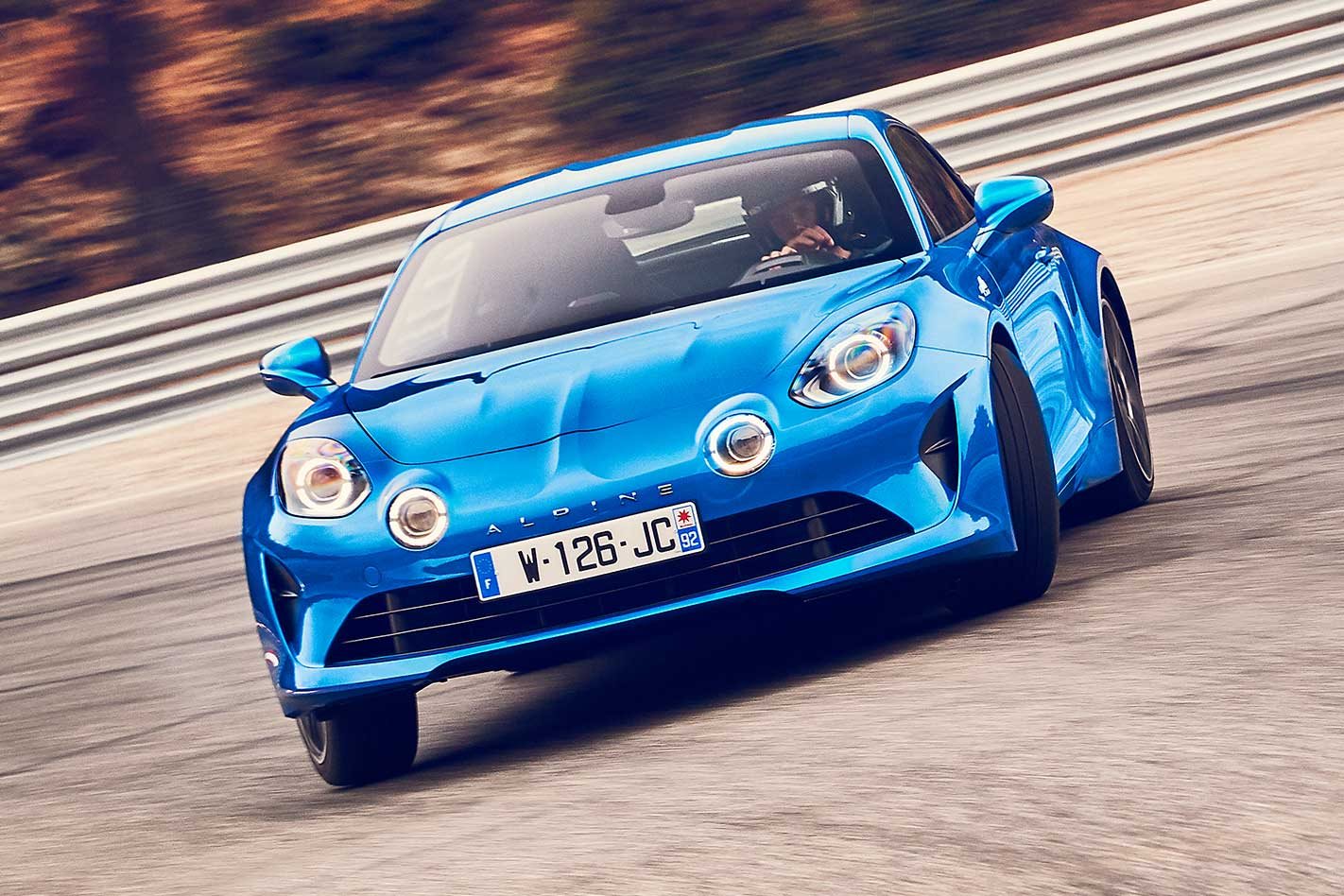The 2018 Alpine A110 is a fast little car that offers a pure, back-to-basics handling philosophy that channels the Mazda MX-5 but with proper power.
It’s also handles a little bit like a Renault-designed Lotus which is not surprising given its development driver Rudy Thomann worked in Lotus’s ride and handling department during the inception of the original Elise.
But what the new French mid-engine coupe has that the Lotus hasn’t is a surprising level of refinement, including a roomy and comfortable if still simple interior.
We’ve just driven the new Alpine A110 in France, a car that heralds the return of the legendary French sports car brand after a 23-year hiatus, the new car finally getting unleashed on the road after five years in gestation.
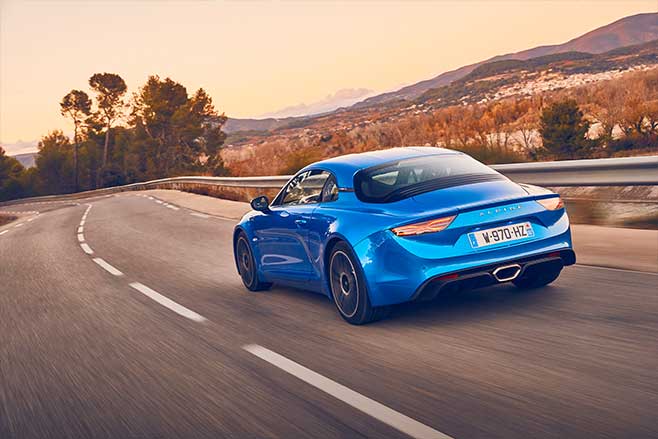
As one of the primary development KPIs, getting the A110’s weight to a target of 1000-1100kg was an immense engineering challenge necessitating a chassis and body made almost entirely from aluminium (96 per cent), a lot of it bonded with special high-strength glue to save further weight from welds and rivets — part of a ‘gram-strategy’-esque approach that is noticeable all over the car.
With the Premiere Edition coming in at 1103kg the Alpine team — compromised mostly of Renault Sport engineers best known for their scintillating hot hatches — achieved their set-out goal.
It also meant 185kW/320Nm from the 1.8-litre turbocharged inline-4, sourced from within the Renault empire (sharing its fundamentals with the Espace engine; and also slated for the upcoming new Megane RS) was more than enough for potent straight-line performance, the A110’s 168kW/tonne the same power-to-weight as a VFII SS Commodore.
With launch control the new A110 will hit 100km/h in a claimed 4.5sec and complete the quarter mile in 12.7sec. The base PDK Porsche 718 Cayman does 0-100km/h in a (admittedly conservatively claimed) 4.7sec.
The A110’s fairly blistering acceleration is despite the lack of a traditional limited slip differential, left off the car to save weight and cost, the Alpine instead distributing torque across the rear axle by individually braking any single-spinning wheels.
The car’s acceleration also benefits a lot from the new seven-speed EDC twin-clutch automatic, a unit shared again with the Espace (but not the upcoming new Megane RS, which will have a different and beefier EDC) but overhauled for sports car use with bespoke ratios and significantly quickened shift speeds. The shift paddles for manual mode are fixed on the steering column, rather than the steering wheel.
Excruciatingly for some would-be owners, the new A110 is not available with a manual gearbox, Alpine bosses claiming there was not enough budget to develop two transmission options to the desired standard, putting their entire focus into the auto instead given its better sales potential.
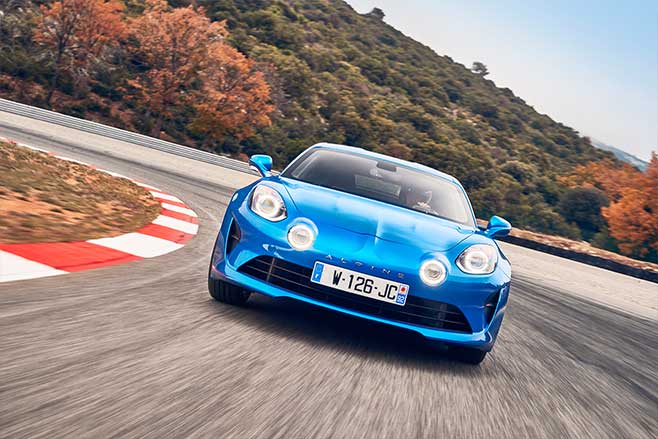
Flick from Normal to Sport to Track mode using the steering-wheel-mounted red toggle button and the A110’s personality becomes noticeably more aggressive and even a tiny bit feral, the bi-modal exhaust opening to reveal a loud and raucous note nearing the 6650rpm redline that reminds us — strangely despite being half the engine — of a Ricardo V8-powered McLaren in its upper revs.
With a proud turbocharged personality there is very noticeably an engine behind you and nothing much in front of you, including the bonnet which disappears below the bottom of the windscreen. You sit low and back in the Alpine, your bum not quite on the road but with the door sills at shoulder height and the dashboard rising up to envelope you in classic sports car style, with a fantastic (and therefore very unFrench) driving position and even more fantastic fixed-back lightweight Sabelt bucket seats — attractive, supportive and generously padded, a real highlight of the car.
Despite the low and set-back driving position, forward and side visibility is excellent; rear visibility is the bare minimum. Sadly there is no engine to peer over in the rear vision mirror through the narrow rear window, just a carpeted panel.
Under full throttle the Alpine squats politely on its rear axle as it angrily unleashes its power, traction strong in a straight line and the EDC swiftly snatching new gears with a loud brap, the engine transitioning from a Clio RS-like intake grumble at low rpm to a baby supercar-esque bark at higher rpm. This is a loud car from the outside, with also plenty of burbles on the exhaust overrun. That all said, the sounds the Alpine makes are more fun and exciting than emotional. A turbocharged four-cylinder will always struggle with that.
For anybody who‘s experienced a supercar the Alpine is not scary quick but plenty exciting as it pushes you back into the seat. You would absolutely describe it as fast, with enough grunt to make it a car not to be reckoned with lightly.
With relatively soft spring rates the A110 feels deliciously light on its suspension, a unique feeling only found in a few new cars, all of them weighing around the 1000kg mark, the MX-5 being one of them.
This feeling of lightness combined with the eager power, and good lateral grip, makes for one very delightfully fun car to drive fast, the suspension also breathing with the road and getting better the faster you go, something we’ve only ever felt on sports cars many times the Alpine’s price.
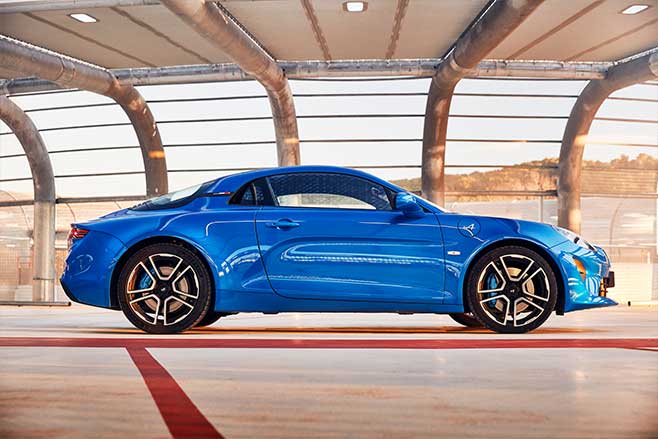
With suspension on the soft side, the Alpine likes a smooth driver. The nose dips visibly as you transition from full throttle to full braking, the body moving through big curves during hard cornering — extra exciting to push the limits of the excellent Michelin Pilot Sport 4 tyres, but also easy to upset the A110 if you’re not smooth enough. The Alpine with classic mid-engine dynamics seems to revel in being grabbed by its scruff and ordered around, but any aggression still must be smooth.
There will be some people who don’t like the extra body movement of the soft suspension and crave less of it, particularly on track. But while it would be possible to fit a firmer set-up and possibly a grippier tyre, to do so with the same amount of suspension genius as the current set-up would be extremely difficult.
With its short wheelbase, fast and precise steering, responsive EDC (which will let you grab two lower gears in quick and crisp succession) and sweetly stacked gear ratios, the Alpine loves a tight and twisty back road, the turbocharged engine supplying flexible low-down torque, the ESC in Track mode also lenient enough to permit a quarter-turn corrective lock on the throttle out of first and second gear corners. If you are smooth, this is an easy and fun car to drive fast, even on faster flowing roads where you can short-shift and surf the turbocharged torque as the engine hisses under boost right behind your head. It is a mega little thing.
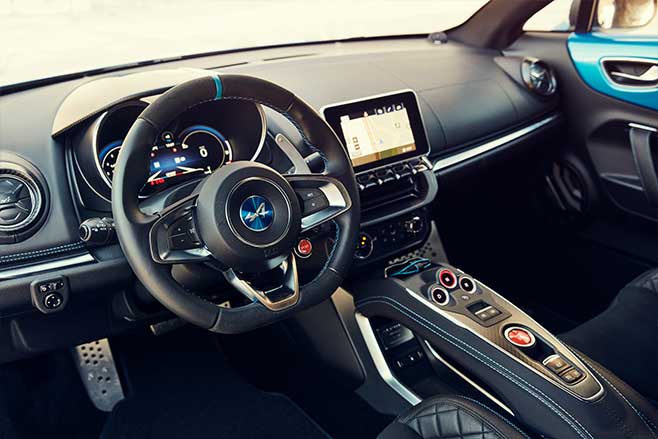
Also the EPAS steering which, while precise and good enough, is nothing special. Throttle response can also be doughy and dulled owing presumably to the inescapable physics of a turbo needing to spool (boost is 1.1 bar or 16psi). We’re probably picking on the Alpine a bit at this point but they rob the driver of connection which in a sports car you can never have too much of.
This car would also be improved by a proper limited slip differential. The open diff and computer braking works well but you can’t simulate the lovely feeling of a proper limited slip differential. It would be the subtle ingredient that improves the recipe.
Aside from luggage space, with a shallow front boot and cute little rear boot both with no chance of dealing with a golf bag (96L and 100L respectively), the interior is where the owner is asked to make the biggest concessions for the Alpine’s cause. While surprisingly roomy for two large adults, cramped in no way, it is a simple, minimalist, almost functional space to be, a bit of an office. And a part of the car Renault clearly used to save some cost on the project.
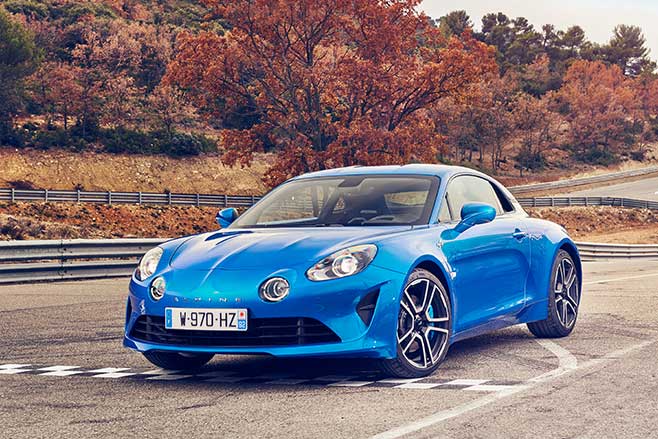
Despite how it looks in the nice press photos, for build and material quality the Alpine interior has nothing on the Germans. That all said, it’s still a nice place to be with its aforementioned rockstar seats, two large TFT screens including instruments, and general refinement including low noise and good around-town ride. This is a more comfortable car than you expect. And if you read enough into Alpine’s history, the slightly budget interior is kind of ‘on brand’.
Quite aside from the lack a manual gearbox which there’s no point moping over, it’s really the interior that costs the Alpine the most marks.
You could also make a case that with its many Renault parts the A110 occasionally feels a little built to a price point in a big car company kind of way, but then you remember its no-compromise aluminium body and chassis. It’s one thing to wonder about the Alpine’s specialness, but there’s no questioning it’s uniqueness. Nor the fact that the way it drives is an achievement.
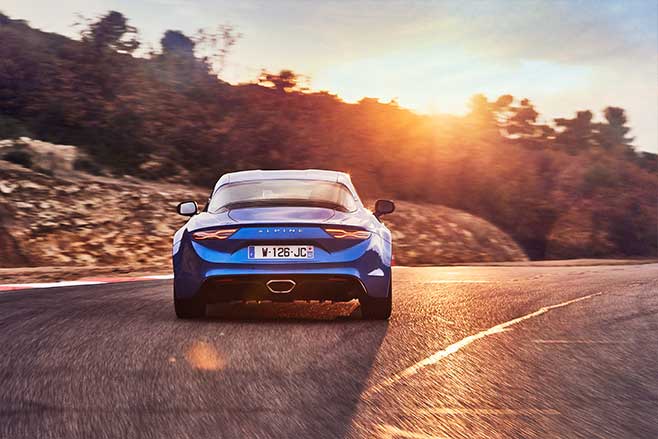
The Alpine A110 arrives in Australia in June 2018, cost to be confirmed but between $90K-$100K.
4.5 out of 5
ALPINE A110 SPECIFICATIONS
Engine: 1798cc inline-4, DOHC, 16v, turbocharged Drivetrain: rear-wheel drive, 7-speed twin-clutch automatic, open differential Power: 185kW at 6000rpm Torque: 320Nm at 2000-5000rpm Weight: 1103kg (Premiere Edition) 0-100km/h: 4.5sec (claimed) 0-400m: 12.7sec (claimed) 0-1000m: 23.2sec (claimed) Top speed: 250km/h (limited) Price: $95,000 (TBC) On-sale in Australia: June 2018
Note on fuel consumption: Alpine claims a combined consumption of 6.1L/100km. We saw 11L/100km on the onboard computer over about 150km of driving, a lot of it pushing the car hard.

